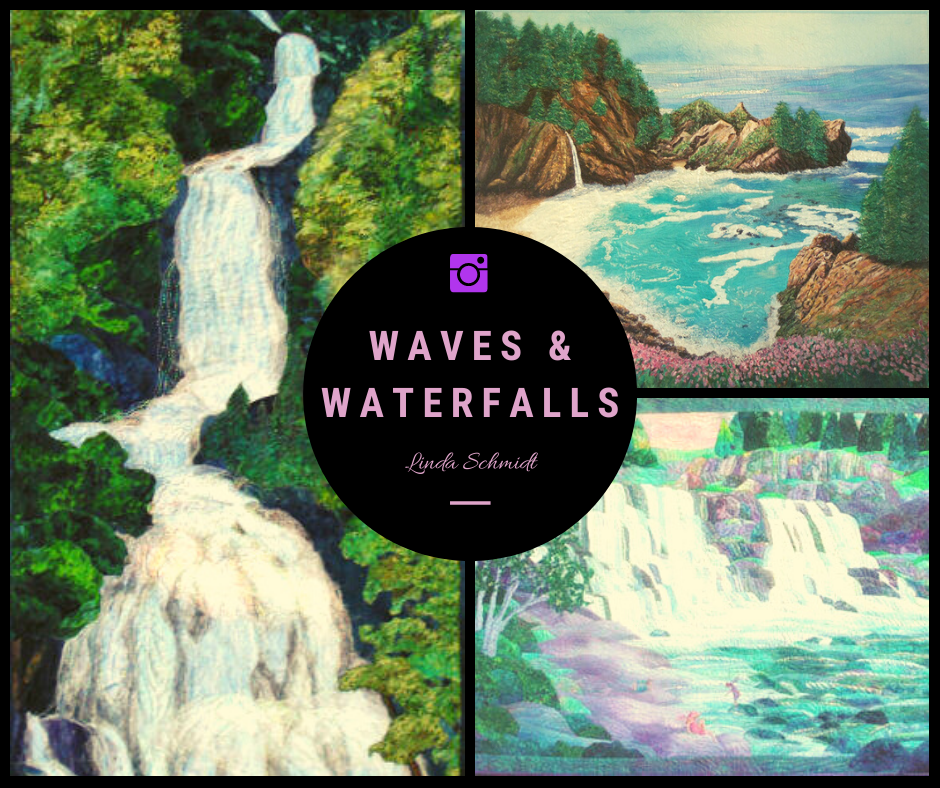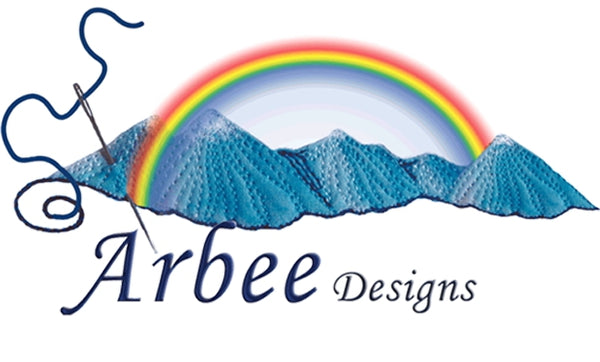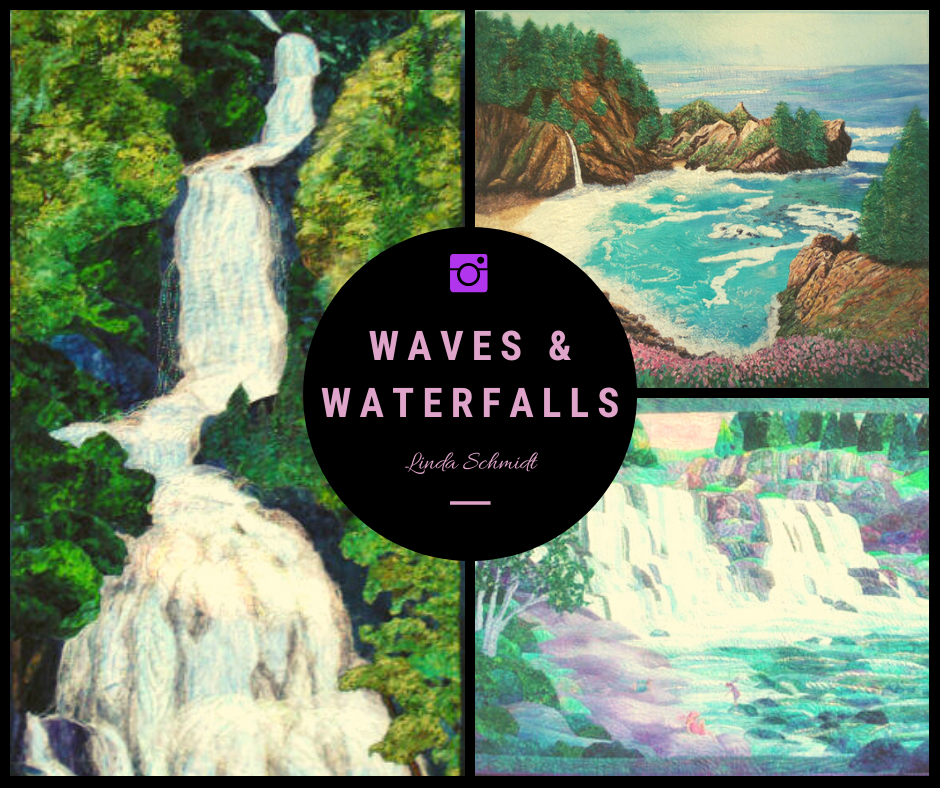
- Description
- Requirements
Join Linda for an exploration of many non-traditional techniques for making moving water, including twisted tuck waves and painted waves. You will embellish with beads, Shiva Paintstiks, Angelina and other fibers and fabrics. In the first three lessons, you will make waves. Lessons Four through Six start with a photo of Yosemite Falls and advance to a waterfall of your own creation. This class involves many different techniques and will require a substantial time commitment. The Supply List includes many of the same items used in Linda's Elements in Fabric class.
Note: Once purchased, you can access the class data any time, 24 hours a day and you get immediate access. (if you don't have an account we suggest you sign up for one prior to purchase)
Time Duration applies only to teacher access for your question and answer duration.
Outline
Lesson One: Catch a Wave!
- Create a line drawing from a photograph
- Use Puff Paint to create sea foam
- Paint the wave with
- Setacolors
- Pearl-Ex metallic paint powders
- Shiva Paintstiks
- Create a Twisted Tuck wave
- Make thread sea foam
Lesson Two: Complete the Wave
- Create sea foam using a heat gun on
- sparkle organza
- fused Angelina fiber
- painted cellophane
- cracked ice or Angelina film
- Create and sew the wave crest
- Finish the final painting
- Create borders
- Quilt it
- Add final embellishments
- Add a focal point with fabric paints
- Add sleeve, bind and label
Lesson Three: Waves on Rocks
- Paint sky and water fabrics with fabric paints
- Create a line drawing and template pieces
- Construct the background ocean
- Start sewing down the rocks
- Create a sandy beach with
- Puff Paint
- Heat gun
- Sand, glitter, and mica chips (optional) and shells (optional)
- Create layers of mist with
- Mistyfuse or other sheer fusible webbing
- Angelina and/or Tintzl fibers
- Finish the background scene by sewing down more layers of rocks, mist, waves, beach
- Quilt it
- Finish the project by adding a focal point and embellishing with Liquid Beadz
- Sandy Shore bonus project
Lesson Four: Yosemite Falls
- Manipulate photos to get a good design
- Create a pattern and templates
- Paint a small sky with fabric paints
- Burn the edges of distant mountains with a candle
- Construct the piece from top to bottom by invisibly appliquéing cliff fabrics to the Totally Stable
- Create the waterfall
- Sew on the rest of the cliffs
- Create pine trees
- Quilt the finished piece
- Bind and label it
Lesson Five: Beginning Your Masterpiece
- Choose your own waterfall photo
- Create your working pattern
- Make waterfall scene elements in advance
- Puff Paint foreground branches or trees
- Puff Painted rocks
- Tyvek rocks
- Fiber Etch leaves
- Individual leaves
- Crashing water on rocks using varied methods
Lesson Six: Constructing Your Masterpiece
- Create the background for your waterfall
- Paint trees on the background
- Pin and sew rocks and background cliffs to the Totally Stable
- Create your waterfall using
- Dark background fabric
- Mistyfuse or other light fusible webbing
- Silk batting, soy or wool roving
- Fused Angelina Fiber
- Create closer trees using fused trunks with painted leaves
- Add rocks and cliffs, making shadows and highlights with inks and/or fabric paints
- Create even closer trees using fused trunks and Fiber Etched leaves
- Create crashing and flowing water with varied methods
- Add borders and quilt
- Sew down Puff Painted branches and/or rocks
- Block and straighten the piece
- Add finishing touches
Supplies Required for Workshop
Fabric to paint, approximately one yard. I use Prepared For Dyeing (PFD) mercerized combed cotton broadcloth, 133 thread count, that I purchase at www.dharmatrading.com. It is also available at many quilt stores. If you do not have access to this, any high thread count, thoroughly washed and dried, white fabric is just fine; like an old white sheet or pillowcase. It is best not to use fabric that is permanent press.
Fabric to make rocks, sand, tree leaves, tree trunks, and some cheater floral fabric to add greenery and something that looks like water fabric as a base when we make water.
Shimmery white fabrics: Small pieces of various types such as white acetate, satin, silk, lining fabric. How much you need depends on how big you make your piece in Lesson Six.
Transparent sheer metallics in white transparent or opalescent colors. Called opalescent organdie, sparkle organza or silk organza. My favorite is "white pearlized sheer metallic" (SKU # 840-8171) from Jo-Ann fabrics. I call it opalescent organdie in the lessons. The best time to find these fabrics in the regular fabric stores is when people are making Halloween costumes, prom dresses or holiday dresses. These are very sheer, fragile, transparent fabrics that will melt if you iron them with a hot iron. You have been warned.
Fabric paints: Any fabric paint will do just fine, as long as you can also get a pearly white along with them. I have used Delta, Jacquard, Setacolors, Versatex, DecoArt So Soft and Lumiere. Use what you have. For water, you need ocean colors, which you can mix from blue, yellow and white or you can get individual colors like:
- Colbalt blue (transparent)
- Ultramarine blue (transparent)
- Turquoise (transparent)
- Emerald Green (transparent)
- Moss Green (transparent)
- pearlescent (perle)
- Titanium White (opaque)
For the sandy beach, rocks, and trees, you will need transparent sand colors like
- Velvet and/or Sienna Brown
- Metallic Gold Silver
- Black Lake
These paints are available at many craft stores. They are also available at www.dharmatrading.com, https://prochemicalanddye.net/ and many other sources.
Painting tools - Paintbrushes, white garbage bag to protect your surface, water and either a palette or several plastic cups to mix your paints in.
Scotch tape - clear adhesive tape (cellotape)
Tracing paper that you see through, not dressmaker's carbon sheets. If you are in a big art store, ask for one sheet of Mylar tracing paper, one side frosted. This is excellent for tracing photographs, as it is clear, but can be written on with a pencil.
Cellophane - about a square yard or enough to wrap around a standard bouquet. It has to be the real cellophane, not a plastic substitute. Get it at florist shops or grocery stores that sell flowers. You want clear, not colored. You can also find it at craft stores in the gift wrap department, called cellophane or clearophane. If you direct a heat gun at it, it will bubble up in tiny bubbles.
Glitter - Silver or gold glitter for the sandy beach, plus iridescent fine glitter to sprinkle on the cellophane. My current favorites are Crystal Assortment Sprinklers from Jo-Ann's, or DecoArt Glamour Dust from Michael's, but any very fine iridescent glitter will do.
Iridescent Glitter Glue (optional) from the craft store
Liquid Beadz (optional): tiny silver ones and the white seed beads mixed with bugle beads. These are beads with no holes that come in a clear glue that you can just smear on your piece to make sea foam. Available online, but if you can’t find it, buy micropearls and a clear fabric adhesive and make your own.
Puff Paint or Xpandaprint: this goes by different names. In the US, it is called Allure Puff Paint, Tulip Puffy Paint, Pebeo Expandable Paint and is available at fabric and craft stores. Make sure the tube you buy says "expands with heat" on it so you do not get the wrong kind. If you cannot get it from a craft store, it is available from www.dharmatrading.com. You only need one tube to make the tree and all the rocks you want for this class, but you might want more later.
Dimensional paint (white or white metallic) that does not puff up when heated. Will not work for trees or rocks, but you can use it as embellishment for your waves. (Highly optional)
Wood burning tool - (about $10 US at most craft stores) Optional for sealing edges of sheer fabrics. Do not get the one with the very sharp blade, it doesn't work. Get the one that comes with about 4 tips and a fairly sturdy, but sharp, rounded blade. The alternative is to use a candle flame.
Heat gun or embossing tool (costs about $15 US at most craft stores). A hairdryer and a fan will also come in handy, but a hair dryer is usually not hot enough to melt cellophane or Lutradur properly.
Batting: I prefer Hobbs or Mathilda's Own wool batting, but whatever works for you is fine with me.
Backing and binding fabric, along with wide sheer ribbons or sheer fabrics to correspond with the quilts (optional) if you make a sheer ribbon border/binding.
White Totally Stable, the size of your finished piece
Freezer paper - available in grocery stores near the aluminum foil and lunch bags
Extra fine glass-headed pins - These will not melt when you iron them.
Solvy: One package of regular or heavyweight, not ultra weight Solvy.
Fusible Webbing - 1 package of very light fusible webbing such as Mistyfuse or Lite Steam-A-Seam 2. Mistyfuse is available from www.mistyfuse.com and many quilting stores. Do NOT use Heat N Bond, it will gum up your needle and does not work with foil.
Iridescent cracked ice or Angelina film: This is totally optional, but very cool. Iridescent cracked ice is a plastic. When heated with a heat gun and put over water fabric, it looks like flowing water. It is available in two sizes, either 2" x 75' roll (called streamers), or 25' x 4' roll. An alternative is Angelina Film in the Winter sampler. This is also more fragile, but you can iron pieces of it together with threads in between, so it is worth playing with.
Angelina fibers are also called Fusible Fibers at Michael’s, Hobby Lobby, Wal-Mart and other craft stores. The iridescent ones are hair-like hologram fibers that will fuse together when melted gently with an iron through tissue or parchment paper; the metallic ones will not bond to themselves but can be bonded in other ways. The colors go by various names, and most craft stores usually sell only the pastel colors. For these classes, you will only need "white", which is called Aurora Borealis, Crystal Green Flash, Crystal Amethyst and/or Crystal Mother-of-Pearl. Get any one of these for clouds, sea spray, waterfall spray - more if your budget allows.
Tintzl or Agfire: Get any "white" color you can find, preferably iridescent green (TZP22) or blue (TZP23).
Fiber Etch - To create fabric leaves, you can use your scissors and spend a lot of time cutting stuff up or use Fiber Etch. (optional), available from www.DharmaTrading.com and many quilt or machine embroidery stores. You will need part of a tube, but do not get this if you are sensitive to fumes.
Lutradur - (optional) You can use this instead of Fiber Etch to make tree leaves. It is made by the Pellon Company.
Shiva Paintstiks are optional, but cool. These are oil-based paint sticks like giant crayons in iridescent colors, but they are very expensive. Ideal colors would be iridescent blue, green, gold and perle, plus plain (not iridescent) white. Six colors are available from DickBlick. If you cannot get the iridescent ones, you can always get the plain set and use Jacquard Metallic paint powders, available at Michael’s craft stores and www.USArtquest.com, to make them iridescent.
Metallic paint powders are very optional. If you cannot find a metallic paint, these powders can be added to any paint or paint extender to make that paint into a metallic paint. In the US, they are available at Michael's, in the art supply section or you can get them from www.USArtQuest.com, www.DickBlick.com or any large art supply store. We will only be using Interference Green and/or Interference blue (which look white in the jar) as well as gold and silver. You need to wear a mask when using this.
Mica chips are also optional. These are tiny vials of crushed mica rock that give sparkle to the sand, but you could also use sand, beads, tiny rocks, glitter up or maybe Mona Lisa metallic foil bits. You can get them from www.USArtQuest.com. I also made perfectly good rocks without them, just using sand and glitter, so do not stress out about this; just know that if you ever see them, they are fun to have.
Quilting gloves of some sort. My favorites are Machingers from www.anniescatalog.com and various other sources.
Topstitch 100 needles: necessary to quilt with metallics and rayons, discounted at www.sewingmachinesplus.com. They are by Schmetz and say "System 130 N Topstitch" needles on them, then they also have a size listed; I like the 100’s. You can get the 90’s at Jo-Ann’s here in the States, and they are probably perfectly adequate for these projects.
Sewer’s Aide is a clear silicone that helps lubricate the thread. You can use this directly on the thread if you have a mechanical tension. If you have a computerized machine, do not use this on the thread. Instead, try to find a place where you could put a piece of moleskin on your machine just before it goes to the needle.
Moleskin is available in the foot care section of the pharmacy. Look at your sewing machine and see if there is a place you could put a little bit of this just above the needle, so you could saturate it with Sewer’s Aide to lubricate the thread right before it hits the needle. If you have no such place and have electronic tension, forget both the moleskin and the Sewer’s Aide.
Threads: You obviously need to have thread to quilt. I haven’t quilted with cotton in 15 years, since other threads are much more fun. My favorites are Yenmet fine metallics, Superior Glitter, Nature Color and NeonBrites threads and Madeira Black Core Metallics, FS20.
Plus, sewing thread, needles, sewing machine, seam ripper, scissors, rotary cutting tools, iron and all of the other stuff you always need.
Sources for Stuff from Around the World
Suppliers in the UK:
ART VAN GO ( www.artvango.co.uk ) carries Angelina Fibers, Tintzl, Xpandaprint or Puff Paint, metallic paint powders, fabric paints
Rainbow Silks, 6 Wheelers Yard, High Street, Great Missenden, Bucks www.rainbowsilks.co.uk/ carries Mica chips, metallic paint powders, Stewart Gill paints, fabric paints, Fiber Etch
Strata, Oronsay, Misbourne Avenue, Chalfornt St Peter, Bucks SL9 0PF Tel: 01494 873850 Tyvek and chiffon scarves
Sheer fabrics: Any Indian fabric shop
www.winklerschulbedarf.com Varied supplies
In Australia: www.thethreadstudio.com
In Canada:
www.maiwa.com pfd fabric
www.kjpcrafts.com Foil
www.currys.com Shiva paint sticks, but not iridescent
www.loomisartstore.com pearl ex pigments

